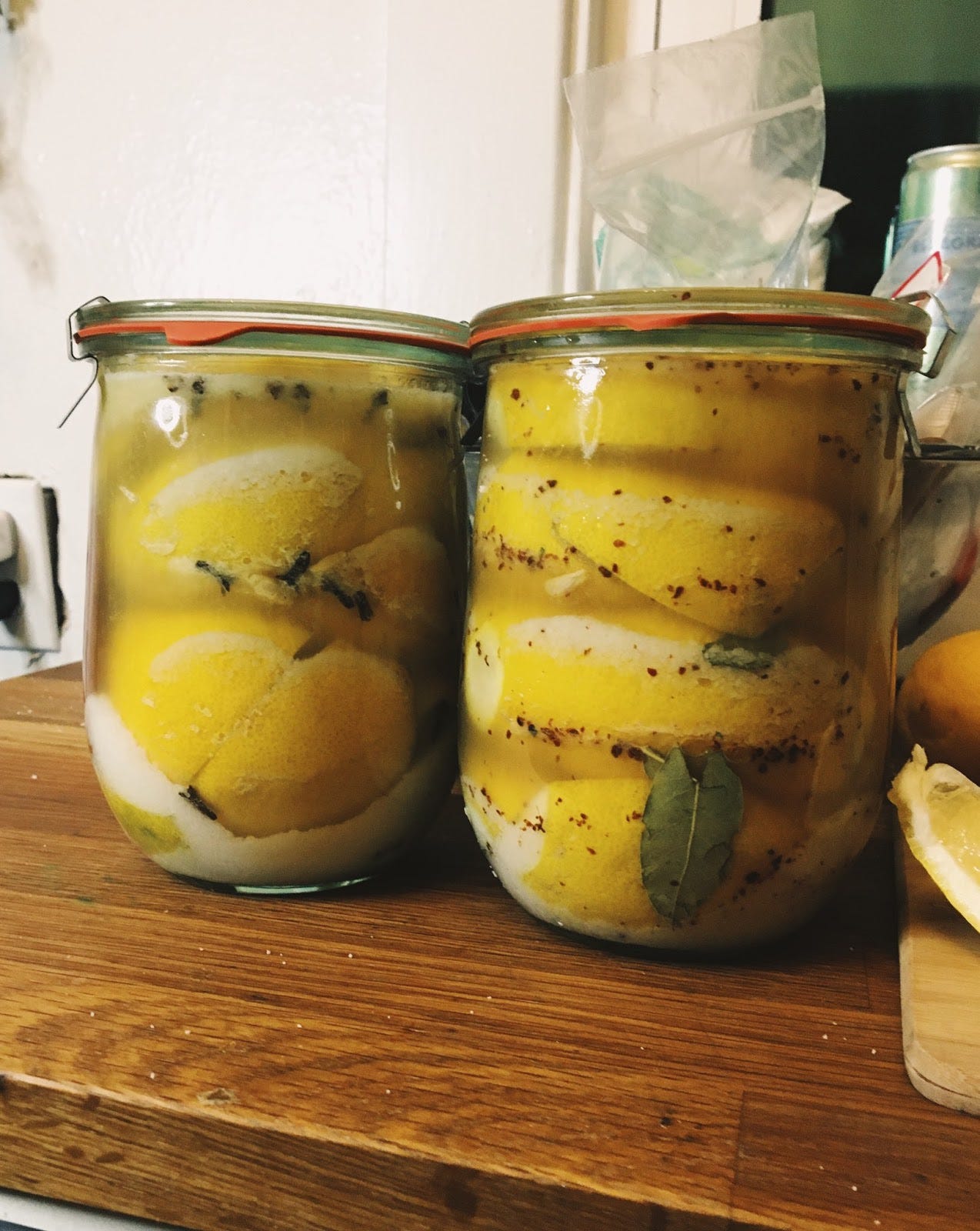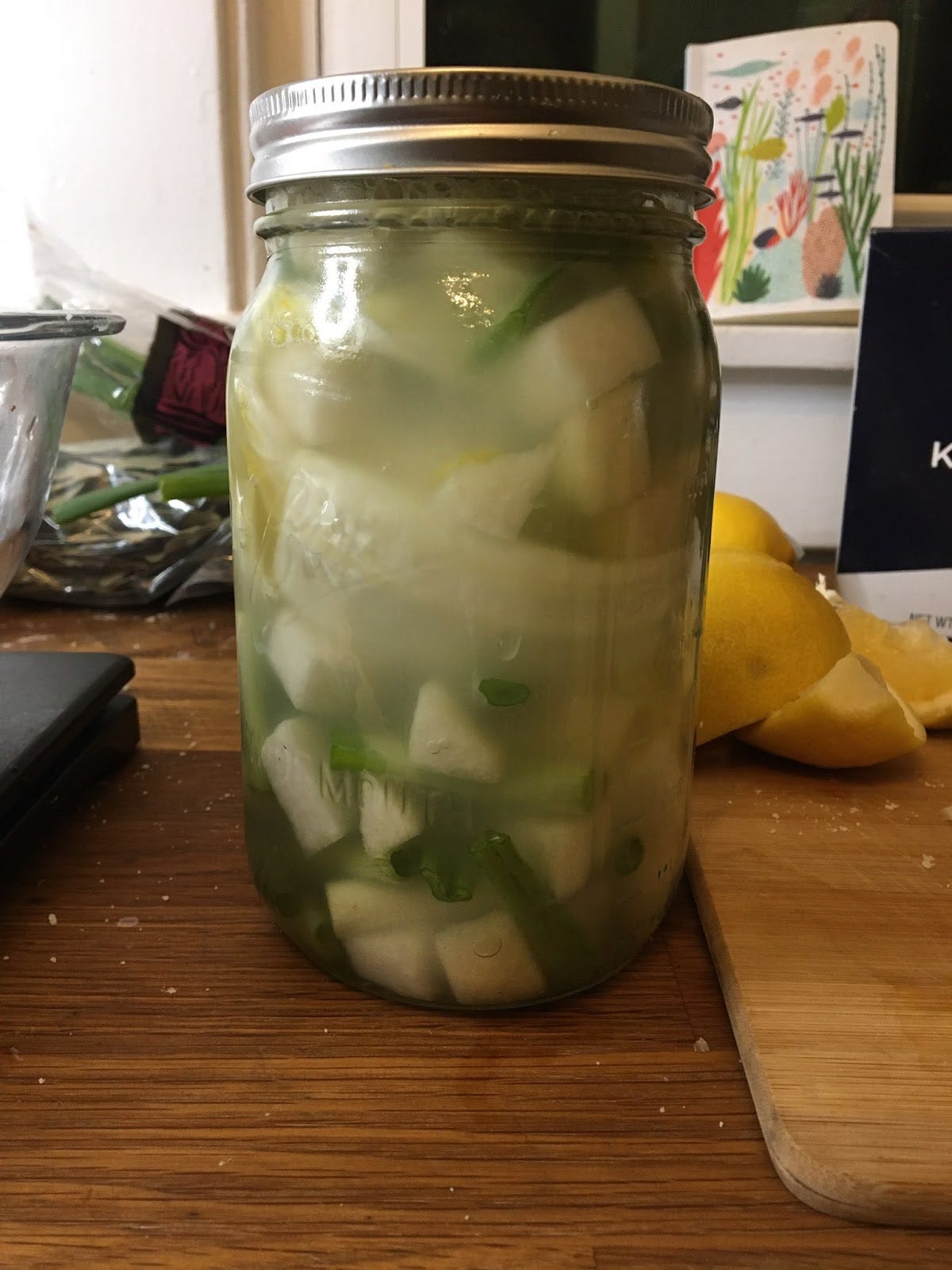INGREDIENTS
12 large, whole lemons, weighted
10-15% of the above weight in kosher salt
1 tablespoon cloves, slightly crushed
6 cinnamon sticks
1 tablespoon aleppo pepper or red pepper flakes
10 bay leaves
Extra lemon juice
TOOLS
2 cleaned and sterilized quart sized Weck tulip canning jars
1 large glass mixing bowl
Scale
Knife
Cutting board
Spoon
Muddler or dowl (optional)
INSTRUCTIONS
Weigh the lemons in grams, then weigh out between 10 and 15 percent of that number in salt. Divide the salt in half. In one half of the salt, mix in the crushed cloves and in the other mix the pepper flakes.
Using a knife and cutting board, remove the ends of the lemons. Quarter the lemons lengthwise but do not cut all the way through, leaving ½ inch of uncut lemon at one end.
Move your lemons one by one to the bowl with the cloves in salt. Spread the lemon quarters open and shovel the salt inside of each lemon until they’re mostly filled. Bury a cinnamon stick inside the salt inside the lemon. Move each lemon to one jar, pressing the lemon as tightly as possible within the jar and sticking cinnamon sticks between the lemons. Sprinkle the rest of the salt on top once the jar is full or about 6 lemons.
Move the rest of the clove salt to the jar on top of the lemons. If the lemons are not covered by juice, use a little more from an extra lemon. Then seal the jar and set aside.
Repeat the process with the pepper salt and bay leaves, with the bay leaves being placed whole inside of lemons. And around the interior of the jar.
Wipe down the outside of the sealed jars of lemons and place them in a cool dark place. Shake them whenever you remember to and let them sit there for up to three months but no less than three weeks.
BAE PEAR WATER KIMCHI, or DONGCHIMI
INGREDIENTS
2 large, firm Korean bae pears, peeled, cored and diced large, about 600 grams
300 grams Korean radish (mu), diced large
1 head of garlic, peeled
1 white onion, quartered
1 thick, 2 inch piece of ginger, peeled and sliced
12 scallions, chopped 2 inches long
2 tablespoons kosher salt
2 tablespoons granulated sugar
4 cups distilled water
TOOLS
2 sterilized quart sized mason jars
Blender
Sieve and cheesecloth
Knife
Cutting board
6 cup or larger pyrex bowl with a spout
Medium mixing bowl
Spoon
INSTRUCTIONS
Prepare your vegetables.
Place 400 grams of the bae pear and the korean radish into a bowl and toss them in the kosher salt and granulated sugar. Set aside for 30 minutes.
Put the onion, garlic, ginger and the last 200 grams of pear into the blender. Cover with 4 cups distilled water and blend well.
Strain the blended product through a cheesecloth and sieve, catching the liquid in a large pyrex with a spout. Discard the solids after straining.
Lightly rinse and strain the pear and radish. Move to the jars, layering with the chopped scallions until ⅞ of the jar is full. Cover in the liquid and close the jar. Repeat with second jar and the remainder of the ingredients.
Place the jar in a cool, dark place for two days.
Begin tasting after 2 days. As fermentation continues, the brine will taste a little bubbly and the radish and apples will become softer. Remember to use sterilized chopsticks or a fork when checking.
After 3-4 days the ferment will be complete. Move to the fridge. Will last for about 2 months.
NOTES
There are 10,000 recipes out there for preserved lemons but I’ve noticed that they usually pop up around late spring/early summer. January is citrus season though, citrus is for the beginning of spring. In Phoenix, many of the neighborhoods around the old canals were built over what was formerly citrus groves. It turns out that if you artificially introduce water to the desert soil, you get remarkably productive material. Many of the houses in these neighborhoods retained old citrus trees, fed by the city’s flood irrigation system. I grew up in a house like this and I remember my mom making preserved lemons when I was growing up. I had her mail me yard lemons this year so that I could make them myself. It will take three months for me to meet it, but I’ve had a strong craving for them.
Preserved lemons are one of those recipes that have an organic multiplicity of a beginning. It’s a recipe at least a thousand years old, showing up in the 11th Century Arabic record and the following century in Egypt. Cambodians have recipes for whole preserved lemons. Indian ayurvedic recipes call for twice as much salt and lean more heavily on spices like turmeric and can be added to chutneys or curries. The recipe I’m using is closest to the traditional Morroccan technique and the product is most famously used in tagine.
Preserved lemons are really savory and incredibly flavorful when they’re done so don’t presume you’re making jam or something sweet when they’re done or you’ll be, uh, surprised. They’re very versatile though, not just for baking chickens or marinades. I have designs to do a bread braid with pepper lemons and za’atar when they’re done but we’ll see and I’ll keep the Plate apprised.
Fermentation and food preservation makes me feel alive. I ran out of kimchi two weeks ago and while I usually have another batch going already, it took me forever to get the ball rolling this time. But having a shelf in my basement full of ferments developing more flavor and probiotics every day puts me in a mood to experiment, and to get back to a comfortable cooking routine where I belong.
I’ve wanted to make a sweeter and more mild kimchi for a while and I love dongchimi. One of the few blessings in Cheyenne is this little kimchi and Korean food company called Mama Boo’s that shows up at every farmer’s market. Her dongchimi is divine.
I had a bunch of leftover pear and mu after making the water kimchi and a ton of paste leftover from Maangchi’s tongbaechu-kimchi so I combined them in a third jar and it’s going to need much more time fermenting than the other two but frankly it’s delicious.
I inventoried and deep cleaned my kitchen and pantry over the last five days and it’s probably a good idea for me to get to cooking more often than I have been. There’s tons of spices and baking products that I haven’t done anything with and they really should go to good use.
Unrelated to anything but I really fucking hate the “Tik Tok Tortilla Hack”. There’s no way that you can actually heat all of the ingredients through that way. I saw one that was a “pasta tortilla” filled with ricotta and pesto and tomatoes. The lady said “this is a great hand held pasta snack”, a phrase which struck me at my core with an inexplicable Lovecraftian horror. I saw another one that was literally just a quesadilla and she called it a “wrap hack”. This is out of control, please stop mutilating your food because the teens on Tik Tok convinced you that something otherworldly and terrifying is actually helpful.





Another banger lunch hour read, both of these look great. I think a tagine or nice curry are in my future
I live in FL so locally grown lemons have been plentiful at the farmer's market; can't wait to try the Preserved Lemons recipe! Thank you.